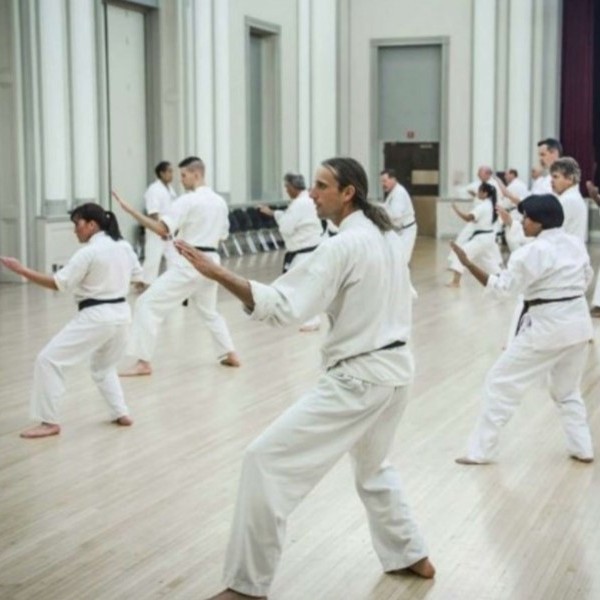Shotokan Ohshima Karate-do and Self-Defense
Teaching traditional karate-do as a serious art and way of life to polish your character
5:45 pm –
7:15 pm
Nebraska Union - Ballroom
Target Audiences:
1400 R St
Lincoln NE 68588
Lincoln NE 68588
Directions: Second floor, double doors on east side of the southern end of north-south hallway running the west side of the building
Contact:
Shotokan Karate of America Club (RSO), (402) 202-7739, techgique@unl.edu
Please see our website and Google calendar for the most up-to-date practice schedule: https://unl.ska.org/karate-class-schedule/
Shotokan Ohshima is a very traditional style and differs from many martial arts schools. Comprehensive, challenging exercise is only one of the many benefits of karate practice. Teaching traditional karate-do as a serious art and way of life means much more. It ensures the original ideas of the founder are passed on to our students, so that we grow in all aspects of our lives. Altman Senpai pushes us to challenge ourselves and taste our life, to be more fully aware and conscientious at all times.
Our karate practice can be very difficult. The main difficulty lies in training one’s mind to be disciplined and focused. Remember, anyone can be lazy, because that is the easiest thing to do!
Karate may be defined as a weapon-less means of self-defense. These techniques use all parts of the body to their maximum advantage. Our fundamental techniques are divided into three main aspects:
Kihon — Fundamental blocks, punches, kicks, and stances
Kata — Pre-arranged forms simulating combat situations
Kumite — Sparring
In each category, the beginner is given instruction at the most basic level until the techniques become spontaneous to them. As the student progresses technically, the practice progresses physically and the student begins to build greater stamina. At this stage, one involves himself or herself with the more intricate and difficult kata and more dynamic forms of kumite.
Karate as self-defense is one of the most dynamic of all the martial arts. The trained karate student is able to coordinate the mind and body perfectly, thereby allowing one to unleash tremendous physical power at will. It is not the possession of great physical strength that makes a strong karateka; rather it is the ability to coordinate the mind and body. Upon developing this ability, even the smallest person finds that within themselves is the power to deliver a devastating blow to any would-be attacker.
The values of karate to modern life are numerous. In our everyday lives we often forget the value of exercise to both our physical and mental health. The practice of karate tones the body, develops coordination, quickens reflexes, and builds stamina.
Also, the serious practice of karate develops composure, a clearer thought process, deeper insight into one’s mental capabilities, and more self-confidence. In this, karate is not an end, but a means to an end. It is an activity in which advancing age is not a hindrance. Rather, it encourages proficiency and the keen coordination of mind and body.
Shotokan Ohshima is a very traditional style and differs from many martial arts schools. Comprehensive, challenging exercise is only one of the many benefits of karate practice. Teaching traditional karate-do as a serious art and way of life means much more. It ensures the original ideas of the founder are passed on to our students, so that we grow in all aspects of our lives. Altman Senpai pushes us to challenge ourselves and taste our life, to be more fully aware and conscientious at all times.
Our karate practice can be very difficult. The main difficulty lies in training one’s mind to be disciplined and focused. Remember, anyone can be lazy, because that is the easiest thing to do!
Karate may be defined as a weapon-less means of self-defense. These techniques use all parts of the body to their maximum advantage. Our fundamental techniques are divided into three main aspects:
Kihon — Fundamental blocks, punches, kicks, and stances
Kata — Pre-arranged forms simulating combat situations
Kumite — Sparring
In each category, the beginner is given instruction at the most basic level until the techniques become spontaneous to them. As the student progresses technically, the practice progresses physically and the student begins to build greater stamina. At this stage, one involves himself or herself with the more intricate and difficult kata and more dynamic forms of kumite.
Karate as self-defense is one of the most dynamic of all the martial arts. The trained karate student is able to coordinate the mind and body perfectly, thereby allowing one to unleash tremendous physical power at will. It is not the possession of great physical strength that makes a strong karateka; rather it is the ability to coordinate the mind and body. Upon developing this ability, even the smallest person finds that within themselves is the power to deliver a devastating blow to any would-be attacker.
The values of karate to modern life are numerous. In our everyday lives we often forget the value of exercise to both our physical and mental health. The practice of karate tones the body, develops coordination, quickens reflexes, and builds stamina.
Also, the serious practice of karate develops composure, a clearer thought process, deeper insight into one’s mental capabilities, and more self-confidence. In this, karate is not an end, but a means to an end. It is an activity in which advancing age is not a hindrance. Rather, it encourages proficiency and the keen coordination of mind and body.
Download this event to my calendar
This event originated in Shotokan Karate of America Club.
